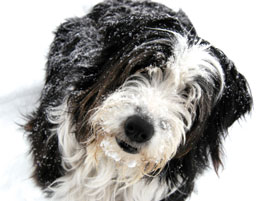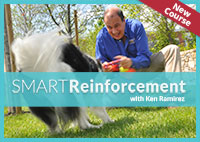Meet the Good and Bad "Fairies"
Anything you do to get rid of behavior you don't want will fall into one of the following eight methods. The first four are the "bad fairies," the methods that have neither kindness nor special efficacy to recommend them. The second four are the "good fairies," the approaches that involve positive reinforcement and some understanding of behavior, and that are highly likely to work. This material, specially adapted for the show dog owner, is based on Chapter 4 of Don't Shoot the Dog! By Karen Pryor.

Method 1. Shoot the animal.
This definitely works. Get rid of the animal, by whatever means, and you will never have to deal with that particular behavior from that particular subject again. In the dog show world, Method One is a common solution to a dog that "won't show." Give the dog away and buy a new and more expensive dog.
Method 2. Punishment.
Everybody's favorite, in spite of the fact that it almost never really works. In the show ring, leash jerks are the commonest punishment (euphemistically called "corrections") but I have also seen dogs stepped on, yanked off their feet, kneed in the ribs, and ear-pinched for not paying attention, for failure to obey a command, and for misbehavior such as growling at the handler. Punishment does not improve a show dog's attitude.
Method 3. Negative reinforcement.
This does not mean doing something negative to the dog when it makes a mistake; it means removing something negative when the dog does something right. For example, during gaiting and stacking in the show ring many handlers hold the leash high over the dog's head, dragging the dog upward. An appropriate use of negative reinforcement would be to slacken the leash whenever the dog holds its head high voluntarily.
Method 4. Extinction.
Letting the behavior go away by itself. For example, playfulness in a puppy, and overexcitement in any dog making its first trip into the show ring, will go away with or without training, as the dog matures and becomes accustomed to the show environment. Clicking for calmness, or clicker training specific behaviors such as focusing on a target, can speed the process of desensitization and help extinguish overreactions.
Method 5. Train an incompatible behavior.
The dog sniffs the ground all the time in the ring? Click it for keeping its nose in the air for two steps, then three, then five, then a ring length, then for longer and longer times. The dog is being paid to keep its head up; it cannot do that and sniff the ground at the same time. Eventually just putting on a show collar and lead can become a cue for "keep your nose off the ground." Training an incompatible behavior—and paying for it with the treats one is allowed to carry in the show ring—is much more effective than punishing the sniff (which encourages the dog to try to sneak in sniffs when you're not looking). It's also more effective than the physical intervention of hauling the dog's head into the air by leash, which will give you a sore arm by the end of the day.
Method 6: Put the behavior on cue. (Then you almost never give the cue.)
This is an elegant way of getting rid of unwanted behavior, but so counter-intuitive that most people just can't bring themselves to try it. Click the behavior; get the dog offering it for the click. Add a cue. Reinforce the behavior when you have cued it, ignore it when you haven't. The behavior will disappear except when cued. This is one way to get rid of puppyish appeasement behaviors such as frantic face-licking, pawing and begging, jumping up, intrusive sniffing, barking and whining, scratching at doors, and (trust me) submissive urination. These are all innate puppy-to-adult-dog behaviors that we often intensify both by getting angry and by inadvertent reinforcement.
Method 7. Shape the absence of the behavior.
Reinforce everything that is not the undesired behavior. This method is particularly appropriate with fearful or aggressive dogs. If the dog does anything normal, click. And treat. Keep the sessions short, keep the reinforcements coming thick and strong, once every ten seconds at least, and repeat as desired.
Method 8. Change the motivation.
Example: the dog in the yard that barks all night, disturbing the neighbors. This is a lonely and frightened dog. Let the dog sleep in the house. Problem solved. Too often, however, modern dog owners try to solve behavior problems by analyzing or explaining why the dog is misbehaving. With the exception of genetically-induced behavioral anomalies (which are hard to diagnose and pin down), it is rarely productive to ask why a dog does what it does. Identify the behavior (not the cause of the behavior). Then identify something you can reinforce that will replace that behavior—and the stuff you don't want will go away by itself.
Related Products
|
|
|











Great advice. I hadn't
Great advice. I hadn't thought of training unwanted behaviors and then decreasing their appearance by hardly ever requesting them. I'm interested to see how this will work for my new puppy!
Post new comment